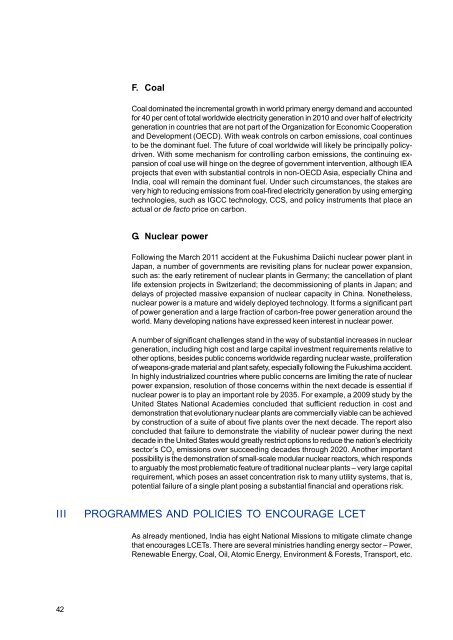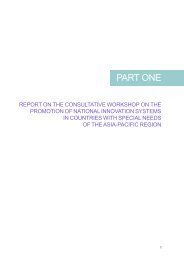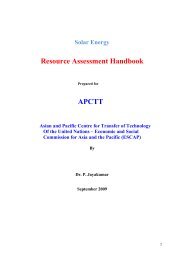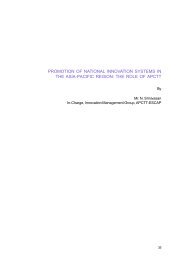Download Complete PDF - apctt
Download Complete PDF - apctt
Download Complete PDF - apctt
- No tags were found...
You also want an ePaper? Increase the reach of your titles
YUMPU automatically turns print PDFs into web optimized ePapers that Google loves.
F. CoalCoal dominated the incremental growth in world primary energy demand and accountedfor 40 per cent of total worldwide electricity generation in 2010 and over half of electricitygeneration in countries that are not part of the Organization for Economic Cooperationand Development (OECD). With weak controls on carbon emissions, coal continuesto be the dominant fuel. The future of coal worldwide will likely be principally policydriven.With some mechanism for controlling carbon emissions, the continuing expansionof coal use will hinge on the degree of government intervention, although IEAprojects that even with substantial controls in non-OECD Asia, especially China andIndia, coal will remain the dominant fuel. Under such circumstances, the stakes arevery high to reducing emissions from coal-fired electricity generation by using emergingtechnologies, such as IGCC technology, CCS, and policy instruments that place anactual or de facto price on carbon.G. Nuclear powerFollowing the March 2011 accident at the Fukushima Daiichi nuclear power plant inJapan, a number of governments are revisiting plans for nuclear power expansion,such as: the early retirement of nuclear plants in Germany; the cancellation of plantlife extension projects in Switzerland; the decommissioning of plants in Japan; anddelays of projected massive expansion of nuclear capacity in China. Nonetheless,nuclear power is a mature and widely deployed technology. It forms a significant partof power generation and a large fraction of carbon-free power generation around theworld. Many developing nations have expressed keen interest in nuclear power.A number of significant challenges stand in the way of substantial increases in nucleargeneration, including high cost and large capital investment requirements relative toother options, besides public concerns worldwide regarding nuclear waste, proliferationof weapons-grade material and plant safety, especially following the Fukushima accident.In highly industrialized countries where public concerns are limiting the rate of nuclearpower expansion, resolution of those concerns within the next decade is essential ifnuclear power is to play an important role by 2035. For example, a 2009 study by theUnited States National Academies concluded that sufficient reduction in cost anddemonstration that evolutionary nuclear plants are commercially viable can be achievedby construction of a suite of about five plants over the next decade. The report alsoconcluded that failure to demonstrate the viability of nuclear power during the nextdecade in the United States would greatly restrict options to reduce the nation’s electricitysector’s CO 2emissions over succeeding decades through 2020. Another importantpossibility is the demonstration of small-scale modular nuclear reactors, which respondsto arguably the most problematic feature of traditional nuclear plants – very large capitalrequirement, which poses an asset concentration risk to many utility systems, that is,potential failure of a single plant posing a substantial financial and operations risk.IIIPROGRAMMES AND POLICIES TO ENCOURAGE LCETAs already mentioned, India has eight National Missions to mitigate climate changethat encourages LCETs. There are several ministries handling energy sector – Power,Renewable Energy, Coal, Oil, Atomic Energy, Environment & Forests, Transport, etc.42







